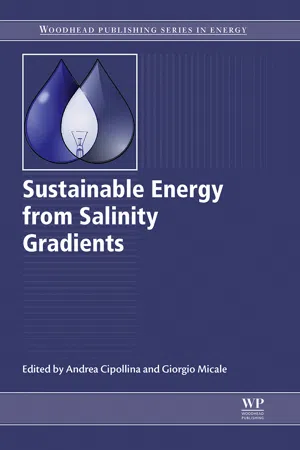
- 362 pages
- English
- ePUB (mobile friendly)
- Available on iOS & Android
Sustainable Energy from Salinity Gradients
About this book
Salinity gradient energy, also known as blue energy and osmotic energy, is the energy obtainable from the difference in salt concentration between two feed solutions, typically sea water and river water. It is a large-scale renewable resource that can be harvested and converted to electricity. Efficient extraction of this energy is not straightforward, however. Sustainable Energy from Salinity Gradients provides a comprehensive review of resources, technologies and applications in this area of fast-growing interest.Key technologies covered include pressure retarded osmosis, reverse electrodialysis and accumulator mixing. Environmental and economic aspects are also considered, together with the possible synergies between desalination and salinity gradient energy technologies.Sustainable Energy from Salinity Gradients is an essential text for R&D professionals in the energy & water industry interested in salinity gradient power and researchers in academia from post-graduate level upwards.For more than ten years the Editors have been sharing substantial research activities in the fields of renewable energy and desalination, successfully participating to a number of European Union research projects and contributing to the relevant scientific literature with more than 100 papers and 2 books on Desalination technologies and their coupling with Renewable Energy. They are intensely working in the field of Salinity Gradient Power, carrying out research with specific focus o.n open-loop and closed-loop reverse electrodialysis and pressure retarded osmosis.- Covers applications of pressure retarded osmosis, reverse electrodialysis, and capacitive mixing for salinity gradient power in one convenient volume- Presents the environmental aspects and economics of salinity gradient energy- Explores possible synergies between desalination and salinity gradient energy
Frequently asked questions
- Essential is ideal for learners and professionals who enjoy exploring a wide range of subjects. Access the Essential Library with 800,000+ trusted titles and best-sellers across business, personal growth, and the humanities. Includes unlimited reading time and Standard Read Aloud voice.
- Complete: Perfect for advanced learners and researchers needing full, unrestricted access. Unlock 1.4M+ books across hundreds of subjects, including academic and specialized titles. The Complete Plan also includes advanced features like Premium Read Aloud and Research Assistant.
Please note we cannot support devices running on iOS 13 and Android 7 or earlier. Learn more about using the app.
Information
Salinity gradient energy
Abstract
Keywords
1.1 Some history on salinity gradient energy technologies

Table of contents
- Cover image
- Title page
- Table of Contents
- Copyright
- List of contributors
- Preface
- Woodhead Publishing Series in Energy
- 1: Salinity gradient energy
- 2: Pressure retarded osmosis: Fundamentals
- 3: Pressure retarded osmosis: Applications
- 4: Reverse electrodialysis: Fundamentals
- 5: Reverse electrodialysis: Applications
- 6: Capacitive mixing and mixing entropy battery
- 7: Salinity gradient engines
- 8: Special applications of reverse electrodialysis
- 9: Salinity gradient power and desalination
- 10: Environmental aspects and economics of salinity gradient power (SGP) processes
- Index